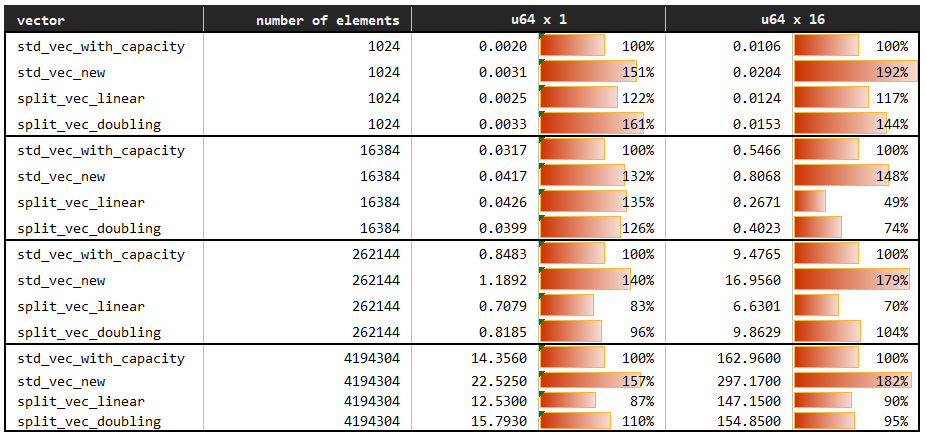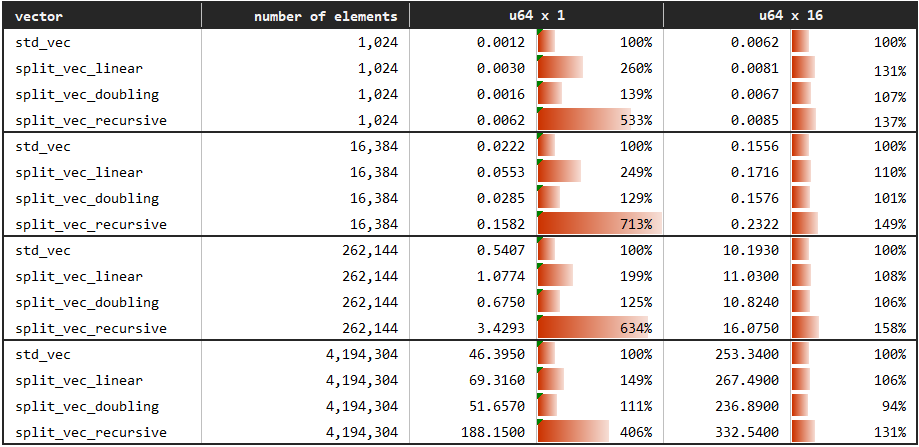Crate orx_split_vec
source ·Expand description
orx-split-vec
A dynamic capacity vector with pinned elements.
A. Motivation
There might be various situations where pinned elements are helpful.
- It is somehow required for async code, following blog could be useful for the interested.
- It is a requirement to represent self-referential types with thin references.
This crate focuses more on the latter. Particularly, it aims to make it safely and conveniently possible to build self-referential collections such as linked list, tree or graph.
See PinnedVec for complete documentation.
SplitVec is one of the pinned vec implementations which can be wrapped by an ImpVec and allow building self referential collections.
B. Comparison with FixedVec
FixedVec is another PinnedVec implementation aiming the same goal but with different features. You may see the comparison in the table below.
FixedVec | SplitVec |
|---|---|
Implements PinnedVec => can be wrapped by an ImpVec. | Implements PinnedVec => can be wrapped by an ImpVec. |
| Requires exact capacity to be known while creating. | Can be created with any level of prior information about required capacity. |
Cannot grow beyond capacity; panics when push is called at capacity. | Can grow dynamically. Further, it provides control on how it must grow. |
It is just a wrapper around std::vec::Vec; hence, has similar performance. | Performs additional tasks to provide flexibility; hence, slightly slower. |
C. Growth with Pinned Elements
As the name suggests, SplitVec is a vector represented as a sequence of multiple contagious data fragments.
The vector is at its capacity when all fragments are completely utilized. When the vector needs to grow further while at capacity, a new fragment is allocated. Therefore, growth does not require copying memory to a new memory location. Priorly pushed elements stay pinned to their memory locations.
C.1. Available Growth Strategies
The capacity of the new fragment is determined by the chosen growth strategy. Assume that vec: SplitVec<_> contains one fragment of capacity C, which is also the capacity of the vector since it is the only fragment. Assume, we used up all capacity; i.e., vec.len() == vec.capacity() (C). If we attempt to push a new element, SplitVec will allocate the second fragment with the following capacity:
Growth Strategy | 1st Fragment Capacity | 2nd Fragment Capacity | Vector Capacity |
|---|---|---|---|
Linear | C | C | 2 * C |
Doubling | C | 2 * C | 3 * C |
C is set on initialization as a power of two for Linear and fixed to 4 for Doubling to allow for access time optimizations.
C.2. Custom Growth Strategies
In order to define a custom growth strategy, one needs to implement the Growth trait. Implementation is straightforward. The trait contains two methods. The following method is required:
fn new_fragment_capacity<T>(&self, fragments: &[Fragment<T>]) -> usizeNotice that it takes as argument all priorly allocated fragments and needs to decide on the capacity of the new fragment.
The second method fn get_fragment_and_inner_indices<T>(&self, vec_len: usize, fragments: &[Fragment<T>], element_index: usize) -> Option<(usize, usize)> has a default implementation and can be overwritten if the strategy allows for efficient computation of the indices.
D. Examples
D.1. Usage similar to std::vec::Vec
use orx_split_vec::prelude::*;
let mut vec = SplitVec::new();
vec.push(0);
vec.extend_from_slice(&[1, 2, 3]);
assert_eq!(vec, &[0, 1, 2, 3]);
vec[0] = 10;
assert_eq!(10, vec[0]);
vec.remove(0);
vec.insert(0, 0);
assert_eq!(6, vec.iter().sum());
assert_eq!(vec.clone(), vec);
let stdvec: Vec<_> = vec.into();
assert_eq!(&stdvec, &[0, 1, 2, 3]);D.2. SplitVec Specific Operations
use orx_split_vec::prelude::*;
#[derive(Clone)]
struct MyCustomGrowth;
impl Growth for MyCustomGrowth {
fn new_fragment_capacity<T>(&self, fragments: &[Fragment<T>]) -> usize {
fragments.last().map(|f| f.capacity() + 1).unwrap_or(4)
}
}
// set the growth explicitly
let vec: SplitVec<i32, Linear> = SplitVec::with_linear_growth(4);
let vec: SplitVec<i32, Doubling> = SplitVec::with_doubling_growth();
let vec: SplitVec<i32, MyCustomGrowth> = SplitVec::with_growth(MyCustomGrowth);
// methods revealing fragments
let mut vec = SplitVec::with_doubling_growth();
vec.extend_from_slice(&[0, 1, 2, 3]);
assert_eq!(4, vec.capacity());
assert_eq!(1, vec.fragments().len());
vec.push(4);
assert_eq!(vec, &[0, 1, 2, 3, 4]);
assert_eq!(2, vec.fragments().len());
assert_eq!(4 + 8, vec.capacity());
// SplitVec is not contagious; instead a collection of contagious fragments
// so it might or might not return a slice for a given range
let slice: SplitVecSlice<_> = vec.try_get_slice(1..3);
assert_eq!(slice, SplitVecSlice::Ok(&[1, 2]));
let slice = vec.try_get_slice(3..5);
// the slice spans from fragment 0 to fragment 1
assert_eq!(slice, SplitVecSlice::Fragmented(0, 1));
let slice = vec.try_get_slice(3..7);
assert_eq!(slice, SplitVecSlice::OutOfBounds);
// or the slice can be obtained as a vector of slices
let slice = vec.slice(0..3);
assert_eq!(1, slice.len());
assert_eq!(slice[0], &[0, 1, 2]);
let slice = vec.slice(3..5);
assert_eq!(2, slice.len());
assert_eq!(slice[0], &[3]);
assert_eq!(slice[1], &[4]);
let slice = vec.slice(0..vec.len());
assert_eq!(2, slice.len());
assert_eq!(slice[0], &[0, 1, 2, 3]);
assert_eq!(slice[1], &[4]);D.3. Pinned Elements
Unless elements are removed from the vector, the memory location of an element priorly pushed to the SplitVec never changes. This guarantee is utilized by ImpVec in enabling immutable growth to build self referential collections.
use orx_split_vec::prelude::*;
let mut vec = SplitVec::with_linear_growth(3);
// split vec with 1 item in 1 fragment
vec.push(42usize);
assert_eq!(&[42], &vec);
assert_eq!(1, vec.fragments().len());
assert_eq!(&[42], &vec.fragments()[0]);
// let's get a pointer to the first element
let addr42 = &vec[0] as *const usize;
// let's push 80 new elements
for i in 1..81 {
vec.push(i);
}
for (i, elem) in vec.iter().enumerate() {
assert_eq!(if i == 0 { 42 } else { i }, *elem);
}
// now the split vector is composed of 11 fragments each with a capacity of 10
assert_eq!(11, vec.fragments().len());
// the memory location of the first element remains intact
assert_eq!(addr42, &vec[0] as *const usize);
// we can safely (using unsafe!) dereference it and read the correct value
assert_eq!(unsafe { *addr42 }, 42);E. Benchmarks
Split vector variants have a comparable speed with (slightly faster than) the standard vector while growing and between 1 - 4 times slower with random access. The latter varies on the element size of the vector and the number of elements in the network. The gap diminishes as either of these factors increases. You may see the details below.
Recall that the motivation of using a split vector is to get benefit of the pinned elements, rather than to be used in place of the standard vector which is highly efficient. The aim of the performance optimizations and benchmarks is to make sure that the gap is kept within acceptable limits.
All the numbers in tables below represent duration in milliseconds.
E.1. Grow
You may see the benchmark at benches/grow.rs.
The benchmark compares the build up time of vectors by pushing elements one by one. The baseline is the vector created by std::vec::Vec::with_capacity which has the perfect information on the number of elements to be pushed and writes to a contagious memory location. The compared variants are vectors created with no prior knowledge about capacity: std::vec::Vec::new, SplitVec<_, Linear> and SplitVec<_, Doubling>.

Allowing copy-free growth, split vector variants have a comparable speed with std::vec::Vec::with_capacity, which can be around 1.5 times faster for u64-sized elements (2-3 times faster for 16-times-u64-sized elements) than std::vec::Vec::new. Overall, the differences can be considered insignificant in most cases.
E.2. Random Access
You may see the benchmark at benches/random-access.rs.
In this benchmark, we access vector elements by indices in a random order. Note that due to the fragmentation and additional book-keeping, SplitVec cannot be as fast as the standard Vec. However, Linear and Doubling growth strategies are optimized to minimize the gap as much as possible.

For vectors having u64-sized elements, the split vector variants are around 2-4 times slower than the standard vector; the difference gets smaller as the number of elements increases. The difference further diminishes as the size of each element increases, as can be observed in 16-times-u64-sized elements (sometimes faster for unknown reasons:).
License
This library is licensed under MIT license. See LICENSE for details.
Modules
- The split-vec prelude, along with the
SplitVec, imports various growth startegies, iterators and finally theorx_pinned_vec::PinnedVectrait.
Structs
- Stategy which allows creates a fragment with double the capacity of the prior fragment every time the split vector needs to expand.
- A contagious fragment of the split vector.
- Iterator over the
SplitVec. - Stategy which allows the split vector to grow linearly.
- A split vector; i.e., a vector of fragments, with the following features:
Enums
- Returns the result of trying to get a slice as a contagious memory from the split vector.
Traits
- Growth strategy of a split vector.